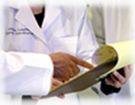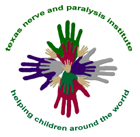(Click here to download full article)
In the old days, it was accepted medical wisdom that the only way to effectively
change the growth pattern or strength of a muscle was to work the muscle. In
other words, the muscle would have to contract. A recent article examines the
research evidence for both NMES and TES used in children with Cerebral Palsy.
(1) Although much of this research is considered anecdotal, each technique
has one "scientifically valid" study that documents change. When
we first introduced TES protocols to the health care community, there was a
fair amount of skepticism. However, 15 years later, it is accepted that TES,
using a low level of stimulation overnight, during sleep, causes growth of
muscle.
In the companion article to this piece, Richard Roseboom and his mother, Vanda,
relate their experiences after adding TES into a their active exercise program.
Richard and his family are very good examples because they have been active
for years and are very compliant with their exercise protocol. They had not
been sitting idle hoping to get better. However, in spite of all the work,
Richard had reached a plateau and his shoulder stability was NOT getting better.
With TES and the Model for Recovery coaching, new muscle growth was achievable,
even in a teenager, Actually, Richard's exercise program works better because
he is a teenager. Puberty is a great stimulus for growth. During puberty, the
body is primed and readied to grow.
As well as new muscle growth, many patients have commented that there is an
apparent increase in sensory awareness after relatively short periods of time
using TES at night. Richard was able to "find" his back muscles,
contract them and so strengthen them. This observation is interesting to me
as a scientist, as there are excellent animal research studies that relate
to this finding. In animals, low-level electrical current has major effects
on the re-innervation process. After direct nerve injury, applying a low-level
electric field improves not only the speed of the regeneration, but also the
quality of regeneration, with an improved number of nerve sprouts. (2-4) There
is some interesting information on the actual mechanisms of this change in
animal studies but equivalent human studies have yet to be done. I think it
is a very interesting area of further research and we can all look forward
to more investigation in the coming years.
However, as both Richard and his family will attest, the new growth of muscle,
while exciting, is not enough to change function. In order to change function
that new muscle has to be strengthened and integrated into daily use. The TASC
Model for Recovery was developed to help individuals integrate the available
information into a focused plan of action. Making a plan and then taking action
is the only way to get a better result.
The Model for Recovery
"How to achieve your child's personal best"
In the Model, we draw on a wide variety of treatments, technologies,
medicine and surgery…whatever is needed to get the best possible result.
Of course, this type of treatment model makes good researchers want to tear
out their hair! One of the problems with doing research in humans compared
to animals is that TES, or any other intervention used in Brachial Plexus
Injury rehabilitation, is difficult to evaluate by itself. Best possible
recovery from BPI requires a multi-disciplinary approach. Many interacting
therapies may need to be used at the same time. In contrast, the aim of formal
research studies is to isolate the individual variables and then study them
one at a time. The investigators work hard to try to isolate the effect of
just one therapy. The problem with this approach is that it is like doing
great surgery without any therapy. We all know the results that you would
get without therapy are pretty miserable. No matter how skilled the surgeon,
therapy pre- and post-surgery will improve the outcome. In Richard’s
case, TES helped his very atrophic, weak muscles to grow. Then he could learn
to activate them. And now, he is working to strengthen them in active movements.
All the techniques he has used have helped and no one treatment would produce
those results if used alone... (Click
here to download full article) |
















